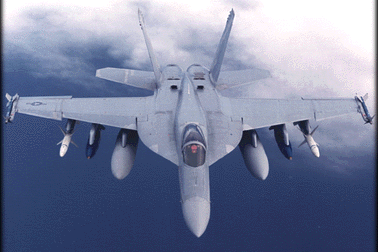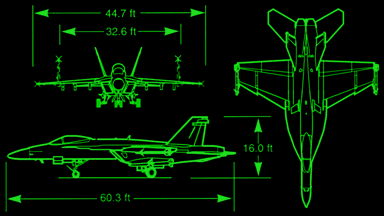

 |
 |
 |
 |
![]()
The multi-mission F/A-18E/F "Super Hornet" strike fighter is an evolutionary upgrade of the combat-proven night strike F/A-18C/D. The Super Hornet will provide the battle group commander with a platform that has significant growth potential, more than adequate carrier based landing weight, as well as range, endurance, and ordnance carriage capabilities comparable to the A-6 and F-14 which are now being retired. The F/A-18E/F is also considerably more survivable than the most recent F/A-18C/Ds which will permit unescorted operations against highly defended targets early in the conflict. The Navy/Industry F/A-18E/F team has developed a remarkably improved aircraft, taking advantage of more than 3,000,000 flight hours experience with the F/A-18A/B/C/D versions; correcting known deficiencies, and adding many new capabilities.
The F/A-18E/F aircraft are 4.2 feet longer than earlier Hornets, have a 25% larger wing area, and carry 33% more internal fuel which will effectively increase mission range by 41% and endurance by 50%. The Super Hornet also incorporates two additional weapon stations. This allows for increased payload flexibility by mixing and matching air-to-air and/or air-to-ground ordnance. The aircraft can also carry the complete complement of "smart" weapons, including the newest joint weapons such as JDAM and JSOW. Additionally, carrier recovery payload is increased to 9,000 pounds, and its engine thrust from 36,000 pounds to 44,000 pounds utilizing two General Electric F414 turbo-fan engines.
Although 41% interdiction mission range increase may be the most dramatic F/A-18E/F improvement, the ability to recover aboard with optimal reserve fuel and a load of expensive precision strike weapons, is of equal importance to the battle group commander. The growth potential of the F/A-18E/F is more important to allow flexible employment strategies in future years. If an electronically scanned array antenna or another valuable but installation-sensitive sensor or weapon system becomes available, the F/A-18E/F has the space, power and cooling to accommodate it. Although the more recent F/A-18C/D aircraft have incorporated a modicum of low observables technology, the F/A-18E/F was designed from the outset to optimize this and other survivability enhancements. The all-F/A-18C/D/E/F air wing brings a quantum increase in capability to the carrier battle group while ensuring the potential to take advantage of technological advances for many years to come.
Roll-out of the first Super Hornet occurred in September 1995, and it flew for the first time in November 1995, ahead of schedule and nearly 1,000 pounds under specified weight. In January 1997, the Super Hornet successfully conducted its initial sea trials on board the Navy's newest aircraft carrier, USS JOHN C. STENNIS (CVN 74). Currently, seven F/A-18E/F engineering and manufacturing development aircraft are engaged in a well-defined flight test program.
The Navy is planning to procure a minimum of 548 Super Hornets. Production of the aircraft commenced in FY 1997, and it is expected to attain initial operational capability (IOC) in FY 2001. Twelve aircraft were funded in FY 1997; procurement numbers increase to 20 in FY 1998, 30 in FY 1999, and reach a final maximum rate of 48 per year in FY 2001. These numbers could vary depending on the progress of the Joint Strike Fighter Program.
The U.S. Navy believes the F/A-18E/F Super Hornet is "the right airplane at the right time." Potential enemies will learn it is hard to find, hard to hit and hard to kill. The F/A-18E/F is on cost, on schedule, and remains under specified weight.
![]()

| DIMENSIONS: | |
|
60.2 ft (18.4 m) |
|
16.0 ft (4.9 m) |
|
44.9 ft (13.7 m) |
| WEIGHT: | 66,000 lbs (29,864 kg) max takeoff |
| SPEED: | Mach 1.8 plus |
| PROPULSION: | |
|
|
| COMBAT CEILING: | 50,000 plus ft (15,250 plus m) |
| RANGE (using only internal fuel): | |
|
420 nautical-mile radius |
|
520 nautical-mile radius |
| ARMAMENT: | |
|
|
| CREW: | |
|
One |
|
Two |
| FIRST FLIGHT: | November 29, 1995 |